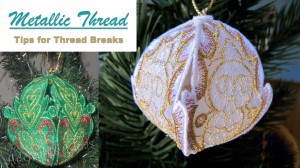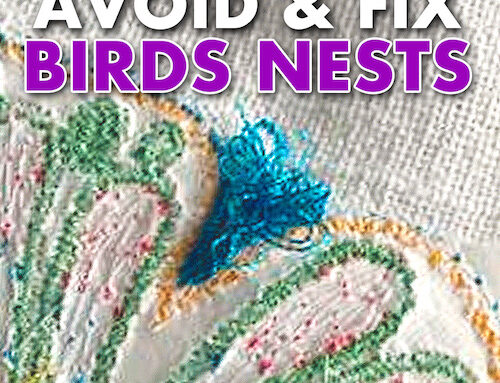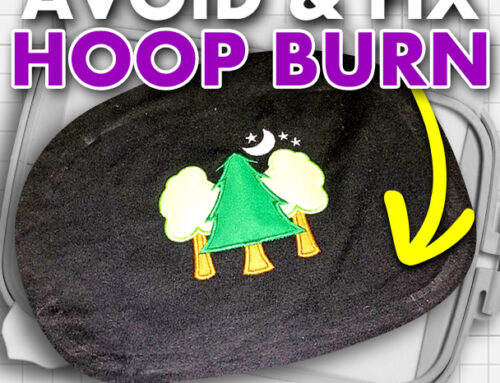Are you struggling with thread breaks on your embroidery machine when using metallic or polyester thread? Metallic thread has an appeal to it that can take your embroidery project from ordinary to extraordinary, but with this benefit often comes struggle.

Metallic embroidery threads are often overlooked as the troublemakers of the thread family. Why? Because for most people, metallic threads constantly break when being used. But in our opinion, metallic thread is simply misunderstood.
Expand your embroidery world and have fun doing it with our new & improved Fun Effects Embroidery Course by learning 14 popular techniques, including using metallic thread, to skyrocket your creative potential.
Why Does Metallic & Polyester Embroidery Thread Break More?
The main reason why metallic threads constantly break is that it’s a synthetic thread type. This makes it stiffer especially compared to Rayon, which is noticeably softer to the touch. Polyester is also a synthetic thread, but it is not as stiff as Metallic.
As a result, the metallic thread isn’t as soft and malleable as other thread types and when twisted, it breaks easier. This is a problem because of how most multi-needle embroidery machines prop up the thread spools being used (vertically rather than horizontally). When a spool is resting upright on one of your embroidery machine’s pegs, the way that the thread comes off the spool naturally causes the thread to twist.

To illustrate this point, think of a roll of toilet paper. If you were to take the toilet paper off while the roll was standing up vertically (the cardboard tube in the middle facing upward), the paper itself would wind up and become kinked. Similarly, as metallic thread continues to twist, it becomes more and more wound up, creating tension.
Now the real issue takes place when the thread hits the eye of the needle. On average, if you were to put a single dot on a piece of thread and run it on your embroidery machine, that dot would pass through the eye of a needle an average of 16 times before being sewn into a project!
Given a large amount of tension already placed on the metallic thread from the constant twisting, the friction of passing through the eye of the needle many times adds fuel to the fire, which increases the chances of the thread breaking.
Interested in learning more about different types of machine embroidery threads and when to use them? Click here.
How Can I Prevent Metallic Thread From Breaking?
Thankfully there is a solution! Rather than having your thread come off the spool vertically, set up the spool horizontally. This will prevent the thread from twisting as it comes off the spool.

To illustrate this point, think about how toilet paper naturally comes off the roll when laid vertically (how it usually is). The paper comes off as it was put on without issue (now whether the toilet paper should be placed over or under is another debate altogether).
Setting up the spool horizontally can be accomplished in a few ways:
- If you’re looking for something less DIY, the Thread Directors will give you a similar result.
- If you want to create something DIY, create something to hold the spool horizontally (this can easily be done with a pencil and a plastic cup, watch the video below to find out more)
Here’s a short video showing you how to create your own horizontal spool holder:
One last tip: SLOW YOUR EMBROIDERY MACHINE’S SPEED DOWN. The faster your machine is running, the more tension you’re putting the thread under. I’d recommend between 300 – 400 stitches per minute for optimal results.
Embroidery Designs Using Metallic Thread
Metallic threads are used for their visual appeal as they enhance the look of your design. Although metallic threads are known to be a bit more problematic, metallic threads can be used on any embroidery design. However, metallic thread can be problematic with stitch-intensive designs as well as designs with short stitch lengths.
Use stitch-friendly designs with your metallic threads to produce the best results with fewer problems. Check out our Embroidery Legacy Design Kit that includes 11 high-quality designs, so you can try for yourself the difference quality embroidery designs make. Or, if you’ve already tried our designs, check out our almost 30,000 different embroidery designs that are soft to the touch and make your machine sing.
Some metallic threads run better than others. As results can also vary regarding the brand of metallic used, be sure to use metallic threads on your embroidery designs that are “reputable” brands, as they tend to run better than “budget” brands. Machine brands and models also may prefer one brand over the next. Do your research depending on your specific machine to prevent the struggle with metallic thread.
DIY ITH Wine Charms Embroidery Project Using Metallic Thread
Try out our in-the-hoop DIY wine charms as a fun and great way to increase your creativity while embroidering since you now know solutions for achieving the best results using metallic threads.
Apply your new knowledge with this project, and add a bit of sparkle to your next drink as a bonus!
Check out our video tutorial below for instructions on how to create your own in-the-hoop wine charms.
Conclusion: Start Using Metallic Thread Without The Struggle
Now that you know what the problem is when using metallic and ways around it, you should try using metallic thread again, this time without the headache!
To apply our suggested techniques, try out our high-quality embroidery designs to see what a difference our designs make. Happy stitching!
P.S. Don’t forget to learn the secrets, tips & tricks behind the most popular embroidery techniques and have fun doing it with our new & improved Fun Effects Embroidery Course.






Wonderful advice. I’ll be glad to try it!
Thank you!!
My pleasure Donna, you’re most welcome 🙂
Nice information I will keep in mind …thanks for this.
My pleasure, glad you enjoyed it!
Will try the cup idea! Any particular brand you find works best? Also, what Needle size/type do you recommend? Thanks for the advice!!!
Hi cgray,
Generally speaking, Floriani thread has always worked well for us. Regarding needles, having run commercial factories we only really change needles when they break. Now I know there will be some needle companies out there telling you to use different needles for different fabric types, thread types, etc. and there may be some merit in what they say. However, we’ve never changed needles like this. That being said, I recommend you contact a needle producer for this information as I’d hate to steer your wrong.
Hope that helps 🙂
– Jesse Deer
I have also found that loosening the machine tension also greatly aids the process. With my machines, I lighten the tension to about 1-1.5. I recommend experimenting with your machine to find the best setting for your situation.
Thanks for sharing Darren!
Oh My God, you are a life saver in disguise. I was ready to chuck it in until i saw your video. Thank you so much for this advise. Keep it going.
Glad we could be of help! Remember learning the art of embroidery takes time! 🙂 Keep up the good work!
Great advise, thank you. I am very afraid to use metallic, and have inly done so once. Unfortunately my little machine can’t be slowed down. Brother SE 400.
My pleasure Tracey! Well, hopefully the other tips can still help you get good results in that case 🙂
SE 400 does have a speed control! On the front of machine there are 3 groups of arrows 1 ,2 and 3 arrows! The slide bar moves to the position you want, Check your manual!
That was the perfect tip! Thank you John!
Glad to hear Mary, thanks for reading 🙂
Thank you for this! I wish I had read it a week ago. I’ve been creating a Star Wars-themed quilt and thought the metallic thread would be perfect for it. But after it broke 9 times in 4 minutes I gave up on it and switched to a more reliable thread. Dang it.
Oh well, there will be plenty more opportunities now that I have your nifty solution!
Thanks for reading Sharon, hopefully this trick works for you 🙂
Recently I have started to embroider on vinyl, do you have any tips for sewing on vinyl?
Elizabeth
Hi Elizabeth, regarding vinyl I would suggest low density and longer stitch lengths, much like the settings for leather.
Great advice. Good to know, as a break in thread, especially metallic leaves a visible blemish in finished work. Keep on with great videos guys.
Thanks for reading Ken 🙂
Thank you so much for the cup idea. I have the thread director, but, don’t seem to have much good luck with it. I will try the cup as it will provide more distance to the needle. Metallic is one of my favorites.
I agree Millie! Metallic looks amazing but is tricky. Let us know how the cup trick works for you
Good info. I also slow down my machine and make sure i have a new needle and good stabilizer
Thanks for reading Peri 🙂 hope this helps making using metallic thread easier!
So… new to this fascinating world & loving it. My issue: The pattern for a FSL design calls for 2 colors. I want to do 1 in poly thread and the other in metallic. I have the “long eye” needle, can I use the same needle for both types of thread? I have a Brother SE2000 that feeds thread horizontally. I’ve read to loosen the tension, slow the speed and be particularly vigilant. Any other suggestions to have a successful and low stress project?
Hi Linda, personally, I use the same needle for pretty much every thread type. Other than a 60wt thread or a thicker thread wt.